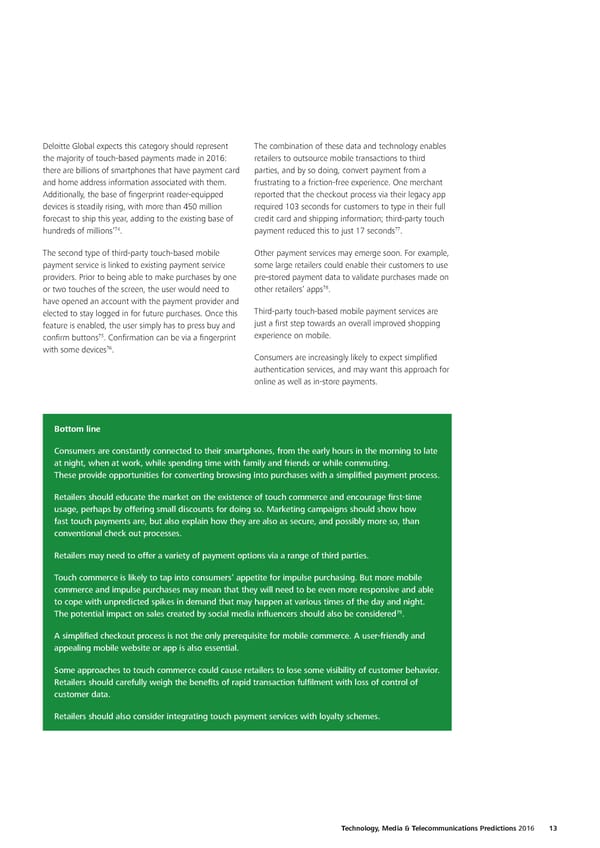Deloitte Global expects this category should represent The combination of these data and technology enables the majority of touch-based payments made in 2016: retailers to outsource mobile transactions to third there are billions of smartphones that have payment card parties, and by so doing, convert payment from a and home address information associated with them. frustrating to a friction-free experience. One merchant Additionally, the base of fingerprint reader-equipped reported that the checkout process via their legacy app devices is steadily rising, with more than 450 million required 103 seconds for customers to type in their full forecast to ship this year, adding to the existing base of credit card and shipping information; third-party touch 74 77 hundreds of millions’ . payment reduced this to just 17 seconds . The second type of third-party touch-based mobile Other payment services may emerge soon. For example, payment service is linked to existing payment service some large retailers could enable their customers to use providers. Prior to being able to make purchases by one pre-stored payment data to validate purchases made on 78 or two touches of the screen, the user would need to other retailers’ apps . have opened an account with the payment provider and elected to stay logged in for future purchases. Once this Third-party touch-based mobile payment services are feature is enabled, the user simply has to press buy and just a first step towards an overall improved shopping 75 experience on mobile. confirm buttons . Confirmation can be via a fingerprint 76 with some devices . Consumers are increasingly likely to expect simplified authentication services, and may want this approach for online as well as in-store payments. Bottom line Consumers are constantly connected to their smartphones, from the early hours in the morning to late at night, when at work, while spending time with family and friends or while commuting. These provide opportunities for converting browsing into purchases with a simplified payment process. Retailers should educate the market on the existence of touch commerce and encourage first-time usage, perhaps by offering small discounts for doing so. Marketing campaigns should show how fast touch payments are, but also explain how they are also as secure, and possibly more so, than conventional check out processes. Retailers may need to offer a variety of payment options via a range of third parties. Touch commerce is likely to tap into consumers’ appetite for impulse purchasing. But more mobile commerce and impulse purchases may mean that they will need to be even more responsive and able to cope with unpredicted spikes in demand that may happen at various times of the day and night. 79 The potential impact on sales created by social media influencers should also be considered . A simplified checkout process is not the only prerequisite for mobile commerce. A user-friendly and appealing mobile website or app is also essential. Some approaches to touch commerce could cause retailers to lose some visibility of customer behavior. Retailers should carefully weigh the benefits of rapid transaction fulfilment with loss of control of customer data. Retailers should also consider integrating touch payment services with loyalty schemes. Technology, Media & Telecommunications Predictions 2016 13
 Technology, Media & Telecommunications Predictions Page 17 Page 19
Technology, Media & Telecommunications Predictions Page 17 Page 19